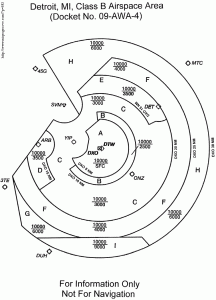
The FAA finalized last week the redesigned Class B airspace over Detroit, Michigan, as proposed August 2012, effective 3 April 2014 to coincide with the next chart cycle.
With this new rule came another discussion of the impact on flight training activities at EMU:
The Class B airspace established southwest of DTW is required to contain large turbine-powered aircraft conducting dual SIILS arrival procedures to Runways 4L/3R, as well as arrivals entering the DTW terminal airspace via the POLAR1 STAR. It extends over approximately three quarters of the Eastern Michigan University (EMU) Aviation flight school’s southern practice area with 3,500-foot MSL, 4,000-foot MSL, and 6,000-foot MSL Class B airspace floors. The EMU southern practice area is subdivided into four sub-areas with virtually no impact to the west northwest sub-area and minor impacts to the southern sub-area, but training activities in the northeast and southeast sub-areas will be limited to 4,000 feet MSL, unless pilots receive a Class B airspace clearance. The FAA does not expect a substantive change to the concentration of VFR training aircraft or training activities conducted in that practice area or the other practice areas located further southwest of DTW under the 6,000-foot MSL Class B airspace shelf. The training activities conducted in those practice areas today could continue under the DTW Class B airspace or within Class B airspace with the appropriate Class B airspace clearance.
Missing from this discussion, again, is the fact that it is often not possible to obtain a Class B airspace clearance in the existing Detroit area. To say that there is “virtually no impact” from expanding Class B airspace seems inaccurate. Maneuvers such as chandelles and power-on stalls often exceed 6,000 feet to conserve time and altitude during training. The airspace changes are likely to cause students to practice these maneuvers at lower altitudes.
Expansion of the Class B airspace designated to the surface appears to intersect the visual route between the EMU southern practice area and the base airport YIP, which will impact that training route and all south departures.
The new airspace certainly brings exciting changes to the entire Detroit area this summer. Be careful to maintain awareness of the new airspace boundaries.
Previous Post: Detroit Airspace Redesign
One response to “New Detroit Airspace Effective April 3”
I am an Eastern Aviation student and I am curious to see how much it will effect our training. It is a pretty large airspace change.